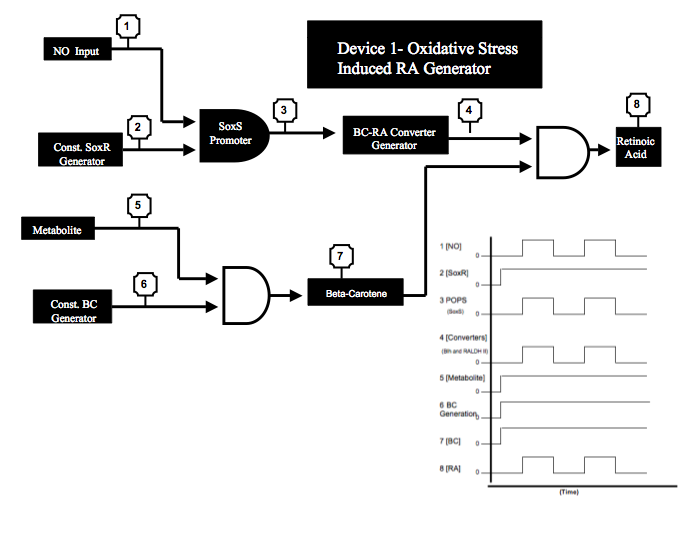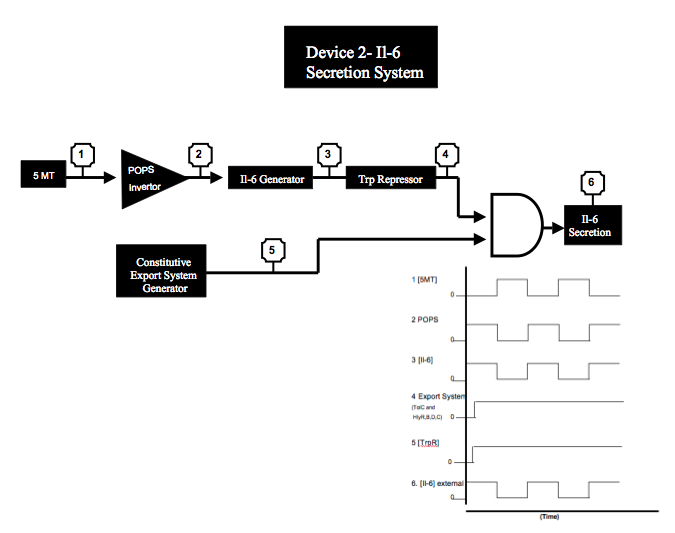Team:Stanford/ProjectPage
From 2009.igem.org
(→==Background and Clinical Significance==) |
(→Abstract) |
||
| Line 8: | Line 8: | ||
Inflammatory Bowel Disease is an autoimmune disease that results in inflammation of the colon and small intestine. IBD is a huge problem in developed countries, vastly growing with no effective therapy in sight. This disease is caused by an imbalance of immune T-cells, Th17 and T regulatory, which control inflammation and immunosuppression responses respectively. We propose a novel mechanism using synthetic biology that aims to regulate this balance ''in vivo''. This involves a two-part device: one that regulates inflammation and the other immunosuppression. We cloned a device that recognizes superoxide producers, a byproduct of inflammation and Th17 proliferation, to produce retinoic acid, which blocks the further differentiation of Th17 cells. This device has been characterized, is well behaved and capable of recognizing superoxides, like paraquat, at optimum levels of 40 to 80 uM without growth inhibition. To control immunosuppression, we cloned and mutated the trp operon so that it recognizes 5-Methyl tryptophan, a target substrate of an enzyme involved in Treg immunosuppression, and designed a potential IL-6 excretion device to regulate Treg proliferation. The behavior of this novel tryptophan sensor has been studied by our group through the development of a mathematical model. Our results suggest that our construct has potential applications as a diagnostic or therapeutic tool for post-operative Crohn's patients | Inflammatory Bowel Disease is an autoimmune disease that results in inflammation of the colon and small intestine. IBD is a huge problem in developed countries, vastly growing with no effective therapy in sight. This disease is caused by an imbalance of immune T-cells, Th17 and T regulatory, which control inflammation and immunosuppression responses respectively. We propose a novel mechanism using synthetic biology that aims to regulate this balance ''in vivo''. This involves a two-part device: one that regulates inflammation and the other immunosuppression. We cloned a device that recognizes superoxide producers, a byproduct of inflammation and Th17 proliferation, to produce retinoic acid, which blocks the further differentiation of Th17 cells. This device has been characterized, is well behaved and capable of recognizing superoxides, like paraquat, at optimum levels of 40 to 80 uM without growth inhibition. To control immunosuppression, we cloned and mutated the trp operon so that it recognizes 5-Methyl tryptophan, a target substrate of an enzyme involved in Treg immunosuppression, and designed a potential IL-6 excretion device to regulate Treg proliferation. The behavior of this novel tryptophan sensor has been studied by our group through the development of a mathematical model. Our results suggest that our construct has potential applications as a diagnostic or therapeutic tool for post-operative Crohn's patients | ||
| - | Background and Clinical Significance | + | ==Background and Clinical Significance== |
talk about IBD in the modern world, immune causes of IBD, what options are currently available for IBD treatment, and shortcomings of these treatments. | talk about IBD in the modern world, immune causes of IBD, what options are currently available for IBD treatment, and shortcomings of these treatments. | ||
Revision as of 22:53, 21 October 2009

| Home | Project | Modeling | Parts | Notebook | Team | SBOL-V |
Contents |
Abstract
Inflammatory Bowel Disease is an autoimmune disease that results in inflammation of the colon and small intestine. IBD is a huge problem in developed countries, vastly growing with no effective therapy in sight. This disease is caused by an imbalance of immune T-cells, Th17 and T regulatory, which control inflammation and immunosuppression responses respectively. We propose a novel mechanism using synthetic biology that aims to regulate this balance in vivo. This involves a two-part device: one that regulates inflammation and the other immunosuppression. We cloned a device that recognizes superoxide producers, a byproduct of inflammation and Th17 proliferation, to produce retinoic acid, which blocks the further differentiation of Th17 cells. This device has been characterized, is well behaved and capable of recognizing superoxides, like paraquat, at optimum levels of 40 to 80 uM without growth inhibition. To control immunosuppression, we cloned and mutated the trp operon so that it recognizes 5-Methyl tryptophan, a target substrate of an enzyme involved in Treg immunosuppression, and designed a potential IL-6 excretion device to regulate Treg proliferation. The behavior of this novel tryptophan sensor has been studied by our group through the development of a mathematical model. Our results suggest that our construct has potential applications as a diagnostic or therapeutic tool for post-operative Crohn's patients
Background and Clinical Significance
talk about IBD in the modern world, immune causes of IBD, what options are currently available for IBD treatment, and shortcomings of these treatments.
Project Overview
Given the project's context in [http://en.wikipedia.org/wiki/Inflammatory_bowel_disease inflammatory bowel disease] (IBD), Stanford iGEM strove to develop a therapy that addresses the weaknesses of current treatments for IBD. Taking a bioengineering approach that could avoid the drawbacks of medications and circumvent the risks inherent to surgical procedures, the team tackled IBD at its source by designing a microbial device able to monitor and regulate imbalances in ratio of [http://en.wikipedia.org/wiki/T_helper_17_cell T helper 17] (Th17) cells to [http://en.wikipedia.org/wiki/Treg regulatory T cells] (Treg). With this project as a model, the team hoped to prototype a probiotic capable of autonomously determining loss of homeostasis and exerting measures to restore the body to homeostasis.
Because the envisioned microbial construct is a biological input/output device, it must have the appropriate sensors to detect Th17 and Treg cell balance and the appropriate generators to output factors to restore balance. First, the team identified two markers of Th17 and Treg activity: [http://en.wikipedia.org/wiki/Nitric_oxide nitric oxide] (NO) and 5-methyltryptophan (5MT) concentration levels. These two markers serve as the inputs to the device. In other words, the device senses concentration levels of these two markers to determine the balance between Th17 and Treg cell populations. If the inputs indicate an imbalance, the device will produce factors to restore balance. The team next identified two factors, [http://en.wikipedia.org/wiki/Retinoic_acid retinoic acid] (RA) and [http://en.wikipedia.org/wiki/Interleukin-6 Interleukin–6] (IL-6), that can control production of Th17 and Treg cells in vivo. Thus the device is engineered to produce heterologous RA and IL-6 in response to signals from the device sensor indicating imbalanced Th17 and Treg populations.
The team chose [http://en.wikipedia.org/wiki/Escherichia_coli Escherichia coli] to use as the chassis for the sensors and generators. The advantages of using E. coli are that the species is well characterized, tractable for bioengineering, and perhaps most importantly, native to the human gastrointestinal microbiota (depending on strain). This last point ultimately enables our device to be assimilated into an IBD patient’s digestive tract, in close proximity to possible sites of disease. Nevertheless, an E. coli chassis is not perfect: it is difficult to construct an E. coli device that can simultaneously sense two different inputs and dynamically output two different molecules.
Thus the team divided the two sensors and generators between two E. coli devices: Device 1 detects excessive Th17 inflammatory activity (through NO) and secretes an anti-inflammatory factor (RA) in response, while Device 2 detects excessive Treg-mediated immunosuppression (through 5MT) and produces an inflammatory factor (IL-6) in response. The primary role of Device 1 is to treat IBD by reducing excessive Th17 inflammatory activity. Device 1 can accomplish this by secreting RA, which inhibits Th17 cell production from naïve CD4+ T cells while at the same time boosting Treg cell production from the same population of naïve CD4+ cells. Device 2 has the opposite role; it produces and exports IL-6, which inhibits Treg cell production from naïve CD4+ cells. The primary role of Device 2 is to prevent Device 1 from overshooting and creating an immunosuppressive state as a result of hyper-stimulation of Treg cell production.
Although the team considered allocating the sensors to one device and the generators to a second device as an alternate way to divide the input and output tasks, such a scheme would require, in addition to the I/O system outlined above, a secondary I/O system that would allow the sensor device to communicate to the generator device. Moreover, such as secondary I/O system would have to be extremely robust, since the gastrointestinal extracellular environment is subject to great amounts of molecular noise. Finally, the devices in this scheme would have to untangle possible crosstalk between the two sensors and two generators. Ultimately, the team decided this division of labor was inferior to the one detailed above.
END SECTION
NOTE: This article assumes that in the previous background section, IBD is linked to an imbalance in the ratio of Th17 and Treg cells.
NOTE: This article spins the story so that Device 2 is used to regulate Device 1, so that Device 1 does not go haywire. Hence, in the background section, we should not consider our project relevant to colon cancer or any other gastrointestinal immunosuppressive disease.
NOTE: assumes that the background section covers CD4 differentiates to both Th17 and Treg cell types.
Previously, we presented two ways cell populations can be imbalanced: too many Th17 cells compared to Tregs, which can result in IBD, and too many Tregs compared to Th17 cells, which can result in excess immunosuppression.
We tailored Device 1 to respond to excess Th17 cells and inflammation. Device 2 is tailored to respond to excess Treg cells and immunosuppression.
Let us begin with Device 1. We want this device to treat inflammation (specifically IBD) due to excess Th17 cells.
ADDITIONAL SECTIONS TO ADD: Future work: our device as indicator expansion of I/O model to all probiotic homeostatic devices
Safety of our device: absorption of 5 MT, Nissle 1917, etc. The net effect is to alleviate the Th17-induced inflammation implicated in IBD. the two devices that exert appropriate effects to bring the populations back into balance. . As will be explained in more detail later, these two E, coli devices sense opposite imbalances between Th17 //whenever the device senses an imbalance between the subpopulations. differentiation of naïve CD4+ cells into of Th17 and Treg cells in vivo greater scope exerted contingent monitor determining
Device 1: Anti-Inflammatory Device
NEED: sBOLv representation of Device 1 Plasmids 1 and 2.
Device 1 is tailored to respond to IBD and gastrointestinal inflammation resulting from excess Th17 activity. Its sensor tranduces NO input into a signal that activates
Slide 22: It accomplishes this by first sensing a Th17 inflammation marker through an inflammation sensor, and then producing an inflammation suppressor in response.
Slide 23: For Device 1, the inflammation signal released by Th17 cells is nitric oxide and the inflammation suppressor is retinoic acid.
To summarize, Device 1 senses nitric oxide, a marker of excess Th17 cells and inflammation. High levels of nitric oxide induce Device 1 to produce retinoic acid, which suppresses inflammation by decreasing Th17 production and boosting production of immunosuppressive Treg cells.
Device 2 is tailored to respond to excess Treg cells and immunosuppression.
Device 2: Anti-Immunosuppressive Device
Add slides of mutant Trp repressor, mut Trp operator
Results
Analysis
Biosafety
- There are no risks regarding our general system design other than the use of probiotics in humans. A few concerns regarding probiotics have been noted from previous iGEM competitors such as NYMU Taipei (2008) and CalTech (2008).
- For our second device, our export system was taken from pathogenic bacteria when they export hazardous material. We use the same proteins involved in the export, however we do not include the hazardous material that they export in our device. (Maybe word this a bit better? Sounds weird to me)
2. Is there a local biosafety group, committee, or review board at your institution? 3. What does your local biosafety group think about your project?
Whoever spoke with the Med Group answer please?
 "
"



